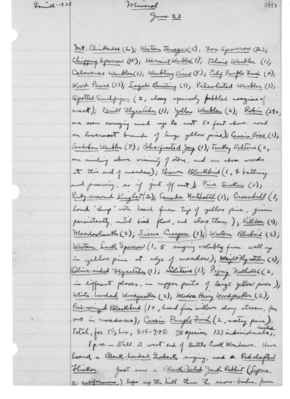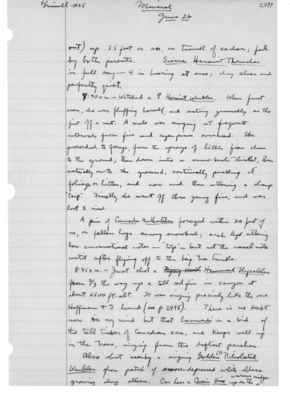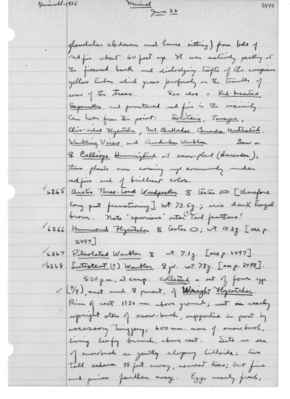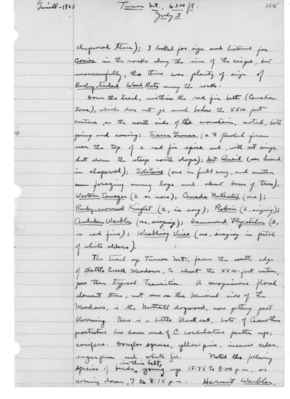Pages That Mention Red-breasted Nuthatch
1925: Joseph Grinnell's field notes
S2 Page 39
Collector: Grinnell - 1925 Location: Mineral Date: June 23 Page Number: 2493
Mt. Chickadee (2); Western Tanager (5); Fox Sparrow (2); Chipping Sparrow (18); Hermit Warbler (3); Tolmie Warbler (1); Calaveras Warbler (1); Warbling Vireo (8); Calif. Purple Finch (4); Wood Pewee (13); Lazuli Bunting (3) Pileated Warbler (1); Spotted Sandpiper (2, along sparsely pebbled margins of creek); Traill Flycatcher (1); Yellow Warbler (2); Robin (29+, one seen carrying mud up to nest 50 feet above and on lowermost branch of huge yellow pine); Cassin Vireo (1); Audubon Warbler (7); Blue-fronted Jay (1); Turkey Vulture (2, one circling above vicinity of store (?), and one above woods at this end of the meadow) Brewer Blackbird (1, [female symbol] bathing and preening, as if just off nest); Pine Siskin (1); Ruby-crowned Kinglet (2); Canada Nuthatch (1); Crossbill (1, loud "chup" note heard from tips of yellow pine, given persistently, until bird flew, and also then); Killdeer (2); Meadowlark (2); Sierra Creeper (1); Western Bluebird (2); Western Lark Sparrow (1, [male symbol] singing volubly from well up in yellow pine at edge of meadow); Wright Flycatcher (2); Olive-sided Flycatcher (1); Solitaire (1); Pygmy Nuthatch (2, in different places, in upper parts of large yellow pines); White-headed Woodpecker (2); Modoc Hairy Woodpecker (2); Red-winged Blackbird (1+, heard from willows along stream, far out in meadows); Cassin Purple Finch (2, mating pair).
Total, for 1 1/2 hrs., 8:15-9:45: 38 species, 133 individuals.
1 p.m. Still at west end of Battle Creek Meadows. Have heard a Black-headed Grosbeak singing, and a Red-shafted Flicker. Just saw a Black-tailed Jack Rabbit (Lepus c. californicus) lope up the hill thru the snow bushes, from
S2 Page 43
Collector: Grinnell - 1925 Location: Mineral Date: June 26 Page Number: 2497
out) up 35 feet or so, on trunk of cedar; fed by both parents. Sierra Hermit Thrushes in full song - 4 in hearing at once, day clear and perfectly quiet.
7:40 a.m. - Watched a [female symbol] Hermit Warbler. When first seen, she was fluffing herself, and attacking generally as tho just off a nest. A male was singing at frequent intervals from fir and sugar pines overhead. She proceeded to forage, from the sprays of little fir close to the ground; then down into a snow-bush thicket, then actually on to the ground, continually picking at foliage or litter, and now and then uttering a sharp "tsip." Finally she went off thru young firs, and was lost to view.
A pair of Canada Nuthatches foraged within 20 feet of us, on fallen logs among snowbush; each kept uttering low conversational notes "Tiys" - but not the nasal note until after flying off to the big tree trunks.
8:45 a.m. - Just shot a Pygmy Nuth Hammond Flycatcher from 2/3 the way up a all red fir in canyon at about 6500 ft. alt. It was singing precisely like the one Hoffmann & I heard (see p. 2495). There is no doubt now in my mind but that hammondi is a bird of the tall timber of Canadian zone, and keeps well up in trees, singing from the loftiest perches.
Also shot a singing Golden ^(?) Pileolated Warbler from batch of snow-depressed white alders growing along the stream. Can hear a Cassin Vireo up on the ^warmer ridge.
S2 Page 45
Collector: Grinnell - 1925 Location: Mineral Date: June 26 Page Number: 2499
glandular abdomen and hence sitting) from bole of red fir about 60 feet up. It was actively pecking at the fissured bark and dislodging tufts of the conspicuous yellow lichen which grows profusely on the trunks of some of the trees. Saw also a Red-breasted Sapsucker, and punctured red fir in the vicinity. Can hear from this point: Solitaire, Tanager, Olive-sided Flycatcher, Mt. Chickadee, Canada Nuthatch, Warbling Vireo, and Audubon Warbler. Saw a [female symbol] Calliope Hummingbird at snow-plant (Sarcodes); these plants now coming up commonly under red firs and of brilliant colors.
6265 Arctic Three-toed Woodpecker [male symbol] testes [illustration] [therefore long past functioning] wt. 73.5g.; iris dark hazel brown. Note "spurious" outer ^(?) tail feathers!
6266 Hammond Flycatcher [male symbol] testes [illustration]; wt. 10.2g. [see p. 2497].
6267 Pileolated Warbler [male symbol] wt. 7.1g. [see p. 2497].
6268 Lutescent (?) Warbler [female symbol] jv. wt. 7.8g. [see p. 2498].
5:00p.m., at camp: collected a set of four eggs 4/4, nest and female parent, of Wright Flycatcher. Rim of nest 1130mm above ground; nest on nearly upright stem of snow-bush, supported in part by accessory twiggery; 600 mm. more of snow bush, living leafy branch, above nest. Site in sea of snowbush on gently sloping hillside; two tall cedars 75 feet away, nearest trees; but firs and pines farther away. Eggs nearly fresh;
S2 Page 65
Collector: Grinnell - 1925 Location: Turner Mt., 6300 ft. Date: July 3 Page Number: 2518
chaparral there); I looked for sign and listened for Conies in the rocks along the rim of the cirque, but unsuccessfully, tho there was plenty of sign of Bushy-Tailed Wood Rats among the rocks.
Down the trail, within the red fir belt (Canadian Zone), which does not go much below the 5500 foot contour, on the north side of the mountain, noted, both going and coming: Sierra Grouse (a [male symbol] flushed from near the top of a red fir spire and, with set wings, shot down the steep north slope); Mt. Quail (one heard in chaparral); Solitaire (one in full song, and another seen foraging among logs and about bases of trees); Western Tanager (2 or more); Canada Nuthatch (one); Ruby-crowned Kinglet (2, in song); Robin (2, singing); Audubon Warbler (one, singing); Hammond Flycatcher (2, in red firs); Warbling Vireo (one, singing in patch of white alders).
The trail up Turner Mt. from the south edge of Battle Creek Meadows, to about the 5500-foot contour, goes thru [sic] typical transition. A conspicuous floral element there, not seen on the Mineral side of the Meadows, is the Nuttall dogwood, now getting past blooming. There is a little black oak, lots of Ceanothus prostratus low down and of C. cordulatus farther up; conifers: Douglas spruce, yellow pine, incense cedar, sugar pine, and white fir. Noted the following species of birds ^in this belt, going up 12:45 to 3:00 p.m., or coming down, 7 to 8:15 p.m.: Hermit Warbler,
S2 Page 81
Collector: Grinnell - 1925 Location: Broke-off Mt. Date: July 27 Page Number: 2533
foliage which the breeze kept in disconcerting agitation); Cassin Purple Finch (2 or more, distantly heard and seen in tops of hemlocks); Sierra Grouse (2, as above); Hammond Flycatcher (2 immatures, separately, seen closely in hemlocks at 8000 to 9000 ft.); Junco (2, in hemlocks).*
In the red-fir belt (Canadian), 8000 ft., about, down to 7000 ft., where we left the machine, noted: Deer (doe and fawn at edge of alder thicket); Callospermophilus (2 or more); Thomomys monticola (sign common); Fox Sparrow (one immature near patch of heather along little stream at 8000 ft., and others heard in alder patches); Juncos (commonest bird, one [male symbol] singing at tip of lofty red fir - many full-grown young in scattering troupes); Evening Grosbeak (one family of 5 or so alighted on dead lower branches of a fir and notes of others were heard now and then); Solitaire (one flushed from ground); Siskin (notes of 2 or 3 heard overhead); Blue-fronted Jay (heard several times); Cassin Vireo (2 immatures closely seen in a jungle of white alders); Hammond Flycatcher (weak call notes heard often, and one bird seen, 30 feet or so up in densely shaded branchwork of fir); Wood Pewee (pair at 7000 ft.); Pileated Warbler (song of one heard from alders); Robin (a pair at a little ^moraine lake in the fir woods was noisily concerned at our presence); Audubon Warbler (a family, male singing, in trees at this same lake); Canada Nuthatch (notes heard in the distance).




